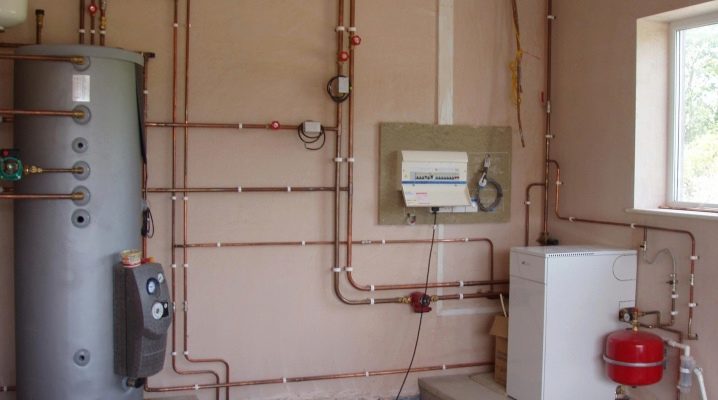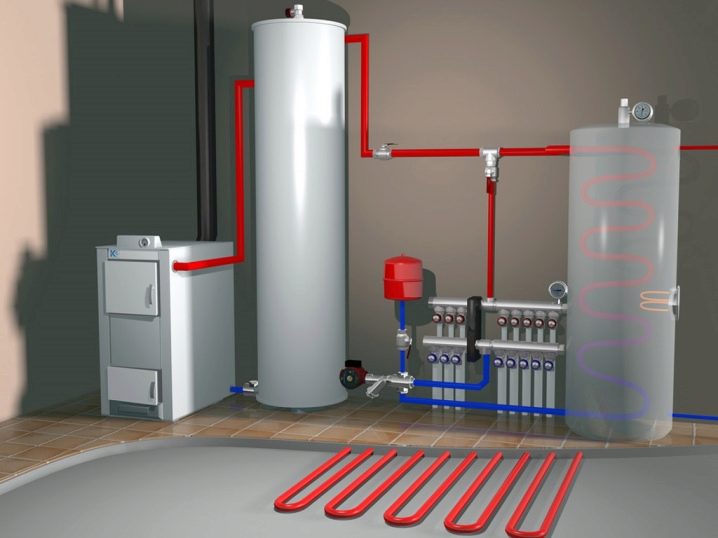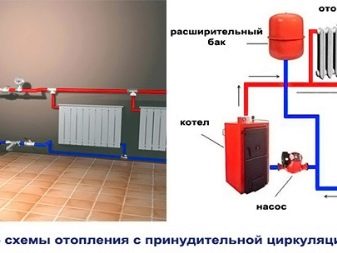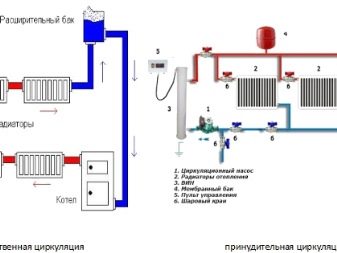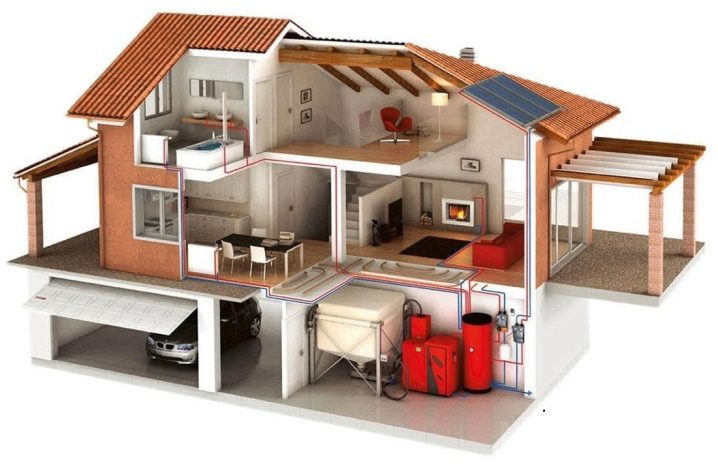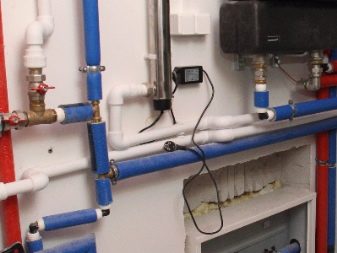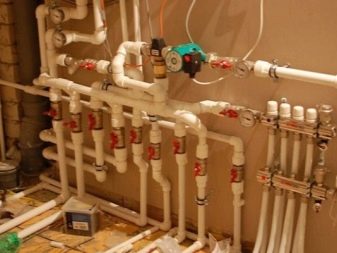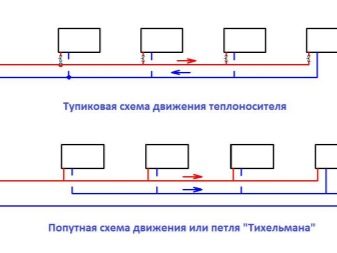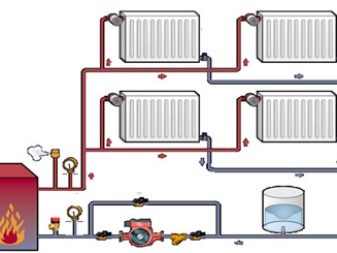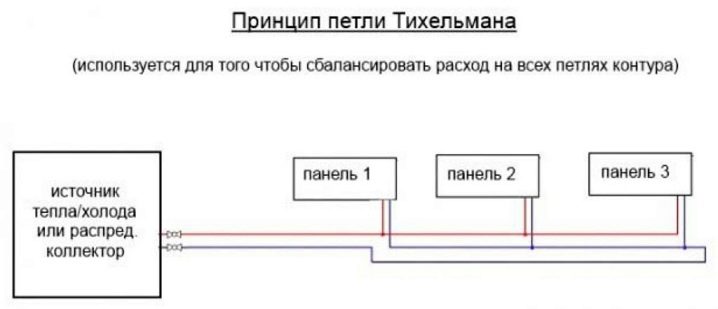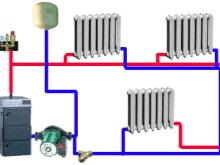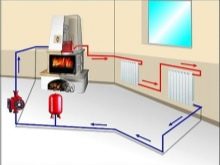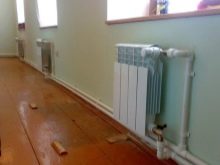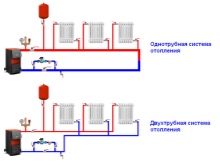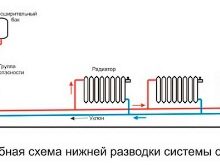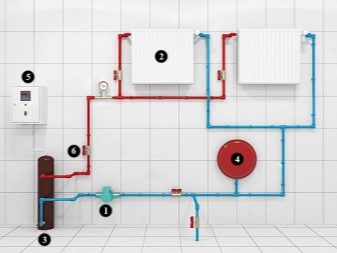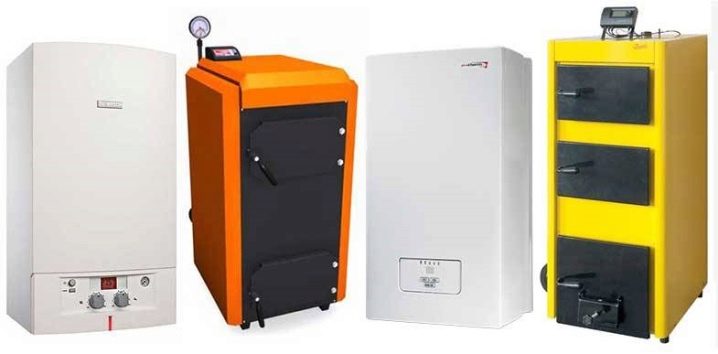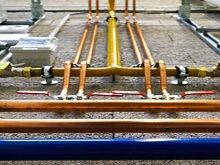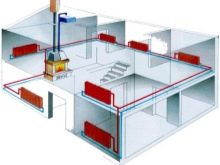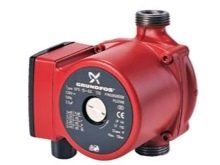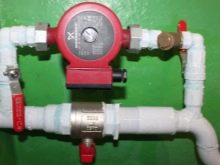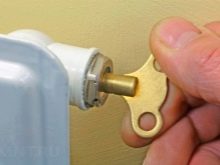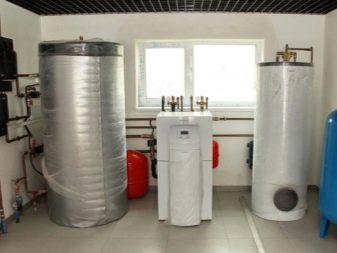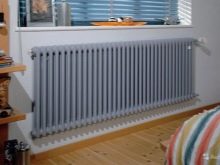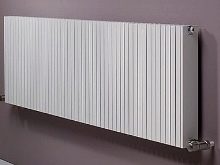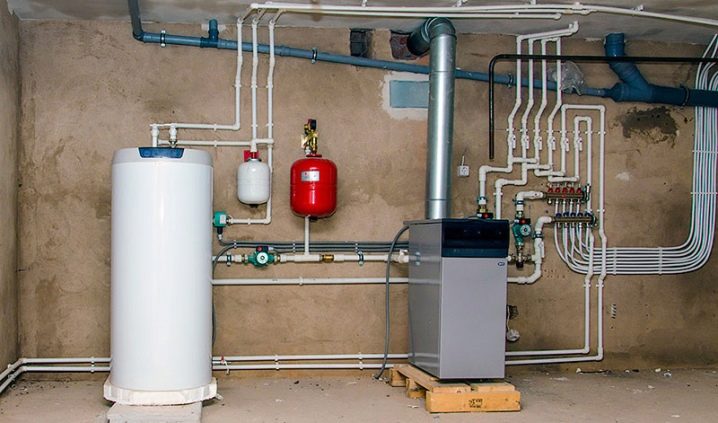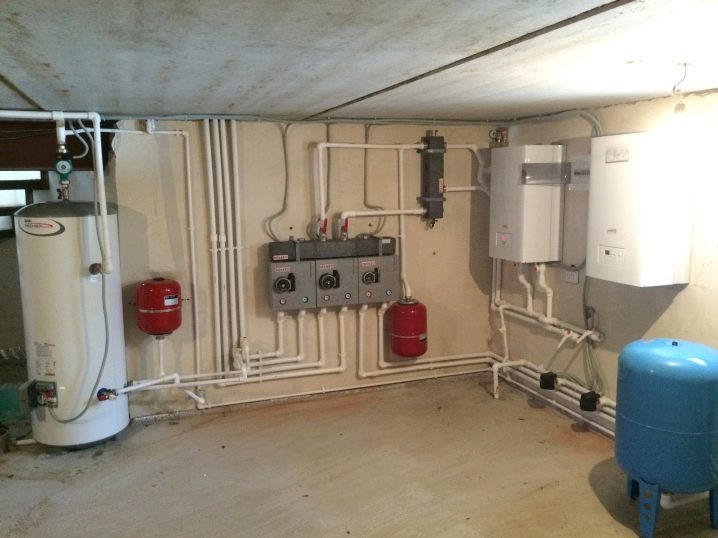Heating system with forced circulation for the home
For a comfortable stay in the house requires an optimum temperature in the rooms. There are many ways to heat rooms. Owners of private buildings face a difficult choice. Quite often used version of the heating scheme with forced circulation for the house. We give the scheme and calculation that will help maintain the necessary comfort in any weather.
Special features
If we compare the method with forced circulation with the natural circulation of water, then the first will be optimal for a two-story building, and the second for a one-story one. For the forced flow of water meets the pump, which is powered by electricity.
The whole point of the forced circulation of the carrier in the heating system is to increase the heating efficiency. In heating with natural circulation, the coolant moves slowly. Therefore, the temperature will be warming worse. Forced circulation in heating is especially important for buildings with a large area where people live permanently. Choosing the right heating scheme is not as easy as it seems: it must comply with certain rules.
In order to understand the existing requirements, you need to understand how the system works with natural circulation. Water is usually used as a heat carrier in standard schemes. Some engineering communications involve the use of special components. The water variant is used in the schemes more often.
For any carriers, the same laws of physics apply: the heated coolant goes up the riser, then all the pipes and heating radiators warm up, the heated carrier forces the cold elements down. Such a cycle is constant in most known schemes.
According to the same laws of physics, the larger the diameter of the line, the greater the amount of carrier will pass through them. This indicator is of particular importance in the natural circulation scheme: if the pipe area is not enough, the room is unlikely to heat up to a comfortable level.The laws of physics can be improved by applying a forced connection scheme. The speed of the carrier is set by the equipment, and not only by the action of physical laws.
Equipment creates pressure, which should be enough to move the carrier. The pump provides a more even distribution of the heated coolant.
The standard scheme of a forced-type heating system includes the following components:
- heating device;
- extender;
- circulating pump;
- radiators;
- pipes;
- connectors;
- filters;
- fasteners.
In order for the system to function as required, the following parameters are important:
- power of the connected equipment;
- pipe size;
- carrier speed.
Let's try to understand the existing types of heating systems in more detail. This knowledge is especially useful if you make the connection yourself.
In general, it is more correct to entrust all calculations and equipment selection to specialists: only professionals will be able to minimize the disadvantages of heating with the forced flow of the carrier.
Kinds
The principle of arrangement of heating with forced circulation is similar to that carried out in systems with a natural course of fluid. Wiring also happens one-pipe or two-pipe.Let us consider in more detail the correct schemes of both types.
Let us examine the nuances of the schemes:
- closed type;
- closed type;
- open type;
- combined type.
There are also options such as:
- gravity heating circuit;
- passing heating scheme.
The currentless heating scheme is practically not used today. However, sometimes there are situations when this option is the only possible, for example, in the absence of electricity and main gas.
The passing diagram is also called the Tichelman loop. Among all existing market offers, this is the easiest way to arrange heating. For all the options, there are two schemes for carrying out the highways, which we will now analyze.
Single pipe
Highway of this type is widespread due to its simplicity. Even traditional one-pipe systems can be completely non-volatile, and even modern versions are automated and very convenient.
The peculiarity of the single pipe line is in the way of connecting the batteries. The single pipe version is a closed circuit of pipes and radiators.Pipes are laid from the heating unit, and the connection of radiators is usually consistent. In this case, the line is removed from the boiler and returns to it. For a single pipe line, many details are not required. Installation of such a system is considered relatively simple.
The merits of such a highway are as follows:
- stability and performance in buildings of any height;
- the use of trunks with a smaller diameter, which is a significant savings;
- the possibility of hidden pipe installation without mounting slope;
- the ability to connect warm water floors;
- temperature stability;
- the ability to adjust the temperature.
The disadvantages of the one-tube version are also available:
- when connecting the pump you need to make accurate calculations;
- to connect the pump requires a stable power supply;
- Some models are very noisy.
Twin tube
As for the variant of two-pipe heating, here each radiator requires a separate line through which the coolant will move in different directions. In this case, the warm contour is usually placed on top, and the cooled carrier returns along the lower line.
This option is suitable for large cottages, where one boiler is used to heat numerous rooms.
This arrangement has its advantages:
- the system is suitable for buildings of any configuration and complexity;
- incoming media arrives at the same temperature;
- for a two-pipe system there is a choice of thermostats.
The negative sides of the system are also:
- a significant negative point is that the installation is more expensive;
- the installation itself is complex;
- the number of components is greater than in the one-pipe version of the arrangement of heating.
Consider detailed schemes for popular species used in private and multi-family homes.
Scheme
If you carefully consider the heating scheme, then you can organize it yourself. As already described above, a two-pipe heating system is suitable for any conditions. It adapts easily to different conditions.
For two-pipe heating, you can easily choose any type of boiler:
- solid fuel;
- gas;
- electric.
If high requirements are placed on the interior design of a two-story private house, then you can consider the collector layout of wiring.If necessary and desired, it is easy to add underfloor heating to a two-pipe heating system.
Experts recommend using a heat accumulator when connected to solid fuel boilers. This addition will be a guarantee of safety and will allow the carrier to boil.
The power used in the scheme of equipment should be closely related to the area of the building. For example, for a large three-story cottage, in addition to the heater, it is important to choose the right pipe material. At the present stage, users often choose steel or polymer versions. Let us consider in more detail the elements that can be included in the arrangement, further.
System elements
We outlined the main details of the heating forced circulating system in the article above.
The correctness of the chosen system will depend not only on the correctly chosen elements, but also on the literacy of their matching. For example, the circulation pump is selected solely according to the size of the room.
Approximately the following examples may be appropriate:
- if the area is 250 sq. m. m., it is worth considering models with a capacity of at least 0.4 atm, 3.5 cu. m. hour;
- for houses of 350 sq. m. msuitable units 0.6 atm, with a capacity of 5.4 cubic meters. m. hour;
- for an area of 800 square meters. meters and above need devices 0.8 atm, 11 cubic meters in capacity. m. hour
In professional schemes, specialists take into account such parameters as:
- length of the highway;
- number of batteries;
- type of valves;
- the size of the pipes, which can be made of polypropylene or steel;
- type of fuel used.
At the wrong assembly of the scheme and calculations in the system of heating air plugs will appear. They are usually observed in the joints of radiators or in vertical risers. Violations in the heating units will help to avoid special taps "Mayevsky." This device is designed to remove air that has appeared in the system, it opens with a simple screwdriver.
Payment
The main parameter on which you should rely in the calculations for installing the system yourself is the power of the heating device. Another important value - the power of heating radiators. You can choose the boiler, focusing on the most affordable fuel. In the calculation may be involved, for example, the unit that runs on gas. Solid propellant aggregates are no less popular in calculation schemes.Boilers for heating can be electric. In the matter of choice you should not overdo it with too powerful units: such equipment may be too expensive. The power of the boiler is calculated correctly taking into account the heat loss. Specialists in this work use complex formulas.
These include such indicators as:
- humidity;
- possible temperature in the rooms;
- outside temperature in winter;
- wall materials;
- number of windows.
Equally important in the types and diameter of pipelines. Polymer or steel pipes have their advantages and disadvantages. For example, steel pipes cannot be joined together without welding. This job requires special training and the availability of tools. Polymer products are easier to assemble, reliable in terms of corrosion.
The batteries used in the scheme can be ribbed, radiation, convective. Characteristics of modern products are quite high, but when choosing, one should take into account that radiation options are rarely used in a heating system of a private house.
In the calculations should be taken into account and the location of the heating devices.For example, the allowable distance from the floor is about 6 cm, to the window sill - 5 cm. It is desirable to place all heating elements located in the same room at the same level.
Tips and tricks
Experts often recommend choosing a heating system with forced circulation for high-rise buildings. However, this scheme may be the only possible one-storey building, especially if the building has a complex configuration.
It is believed that the diameter of the mounted pipe for a system with forced circulation is not important. However, this rule is valid if the speed of the coolant is the same on all sections of the line.
It is believed that for a system with forced circulation, you can choose smaller radiators. This rule applies to accurate calculations. In other cases, you can get an inefficient heating of the premises.
If the calculation of the system is made correctly, the heating of the elements of the system will be uniform. If temperature fluctuations are present in certain areas, the material of the elements will be adversely affected, as a result of which the service life of the parts will be significantly reduced.
Of great importance in the system of forced type have the characteristics of the pump. The parameters of this device affect the heat carrier. With the pump to regulate this figure can not only the boiler.
Since the presence of a pump requires an electrical connection, the device can quickly fail if the voltage is unstable. An uninterruptible power supply will solve the problem with frequent power cuts and save expensive equipment from premature failure.
Since the pump with this method of heating must be turned on all the time, then, of course, the cost of electricity will increase. It is possible to reduce waste due to the installation of pipes with a smaller diameter, since in them the coolant flow rate is smaller.
Sometimes pumping equipment creates excessive noise. You can fix the problem by installing the equipment in a separate room. If the area of the house does not allow it, you should not consider the option of placing a noisy pump in the bedroom. If the system with forced circulation is designed correctly, the house will be surely comfortable and warm.
About the heating circuit with forced circulation, see the following video.
